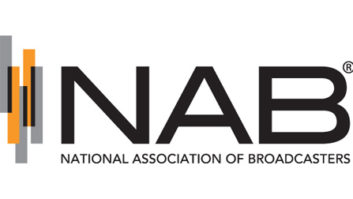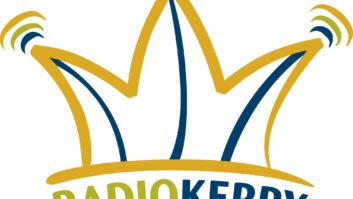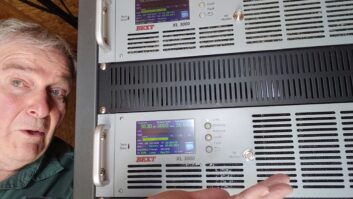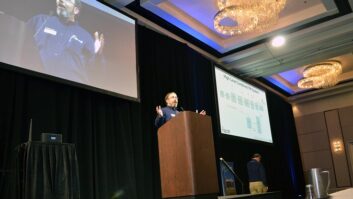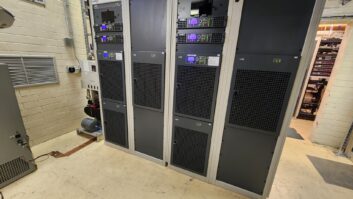Former ERI Owner Deemed Great Engineer, Teacher and Friend
BALTIMORE “He was a good engineer, but he was a great man.”
The speaker is Tom Silliman, president of Electronics Research Inc., talking about his father, Robert. The elder Silliman died earlier this year at age 87.
Engineers recall Robert Silliman as a man with exacting standards, a passion for spreading knowledge of his work, and a wicked wit.
Many peers said Robert Silliman’s “talk down method” of AM directional antenna adjustment might be his biggest contribution to the profession.
NASA buddy
Robert Silliman earned his bachelor’s degree in electrical engineering at the University of Minnesota in 1936, then spent several decades rubbing elbows with engineering pioneers.
Silliman befriended Robert Gilruth when both were boys. Gilruth went on to become the director of the Mercury astronaut program and later the Manned Spacecraft Center in Houston, now called the Johnson Space Center, for the National Aeronautics and Space Administration.
Silliman worked under the direction of Dr. Jean Piccard to conduct experiments with high-altitude balloons in the 1930s. He began a 50-year practice in radio consulting in 1946 and worked as an engineer for the FCC, Harvard University’s radio research lab and the Bureau of Aeronautics for the U.S. Navy during World War II.
Robert Silliman received a Lifetime Achievement Award from the NAB in 1993.
“We were closer friends than we were father and son,” said Tom Silliman. He worked on engineering projects with his father’s help, throughout high school and college. The working relationship between father and son continued for four decades.
“I’ve got a stack of patents 6 inches tall. … He patented the 425 high-power isolation transformer which, even today, is considered the ‘Cadillac’ of the AM/FM combining transformers available in the world today,” said Tom.
“I designed that with him over a Christmas vacation when I was in college. … He patented that.”
Robert Silliman hired broadcast engineer Jim Kemman to work with the consulting firm Silliman, Moffatt and Kowalski in 1964. Kemman was the engineer for WLAN(AM-FM), Lancaster, Pa. at the time. Kemman said Silliman was a key problem-solver for some big clients, such as NASA.
“I think they had a problem with a down-range tracking station at one point,” said Kemman. So Silliman traveled to Chile and helped to solve that problem, Kemman learned.
“NASA had an array of dipoles that they were building in various countries,” said Tom.
“He (Robert) analyzed the array. … The end result was that the antenna was screwed up and his firm straightened it out.”
Teacher
Robert Silliman’s relationship with Electronics Research Inc. began in 1947, according to Kemman, when Silliman was contracted to consult for ERI. At that time, Silliman began a parallel career as an antenna manufacturer, and he would later buy ERI, then located in Evansville, Ind., and become the company’s president and chairman.
Ben Dawson, P.E., managing partner and senior engineer for Hatfield and Dawson, said Robert Silliman also possessed other skills.
“Of all the engineers that I have ever known, and I’ve known a bunch, Bob was easily one of the two or three best teachers.
“He was just a wonderfully gracious person. … When we had a question about some more esoteric part of antenna engineering, we’d bounce our ideas off Bob,” Dawson said.
On Feb. 12, 87-year-old Robert Mitchell Silliman died in Baltimore. Tom said his father’s health had been declining since he suffered a stroke in 1997.
What will Bob Silliman be most remembered for?
“Through his company, Electronic Research, he really pioneered the production of high-quality, mass-produced site-mount FM antennae,” said Dawson.
“Until Bob began the production of really good antennas, the ones you could buy were not terribly satisfactory. Some of his techniques have great practical application that are, even now, not well understood.”
Tom Silliman used this anecdote to best describe his father: “In 1964, the summer before I went to college, he said, ‘I need you. I’ve got a lot of work this summer. I’m shorthanded. I want you to come down to the consulting firm.’ I made about four dollars an hour.
“I went to Cornell at my freshman year, and they told us that the future of the world was computers. If you didn’t understand computers by Christmas, you flunked out. The language Cornell was using was CORC (Cooperative Online Resource Cataloging).
“I learned CORC and I was programming CORC. When I went home for Thanksgiving, I took a couple of my programs and brought them home to my dad. We sat down and had bourbon and I said, ‘Let me show you what I’m doing at Cornell.’ I took this book out and … I showed him the printout, I showed him the language. That night, he read my book.
“He went down to his office and copied all hundred-some pages of that stupid book. He said, ‘You know, you’re right. I’ve got to learn this.’
“When I came back at Christmas, his whole office was computerized. That’s how innovative he was. He was the first consulting engineer in the United States, to my knowledge, to program the calculations in the computer instead of doing them by hand,” said Tom Silliman.
Robert Silliman is buried at Lakeview Cemetery in New Canaan, Conn., where his ancestors settled in the early 1700s.
He is survived by his wife of 62 years, Elizabeth; three daughters; son Tom; and nine grandchildren.







